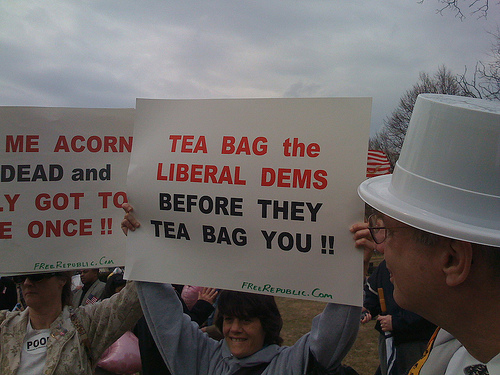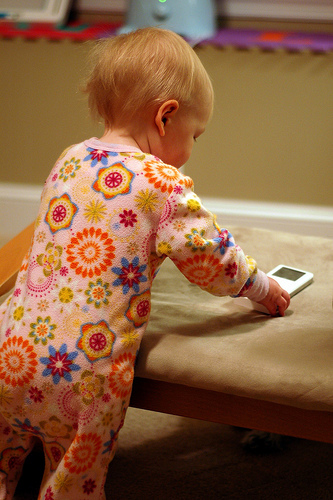The New York Times has an article on how digital cameras and the Internet are transforming the photography business. The striking thing about the article is that it focuses almost entirely on the losers—incumbent professional photographers who are seeing increased competition push down their incomes—and only obliquely acknowledges the big picture, which is that what’s bad news for a small cadre of professional photographers is good news for almost everyone else. We’re informed that “amateurs, happy to accept small checks for snapshots of children and sunsets, have increasing opportunities to make money on photos but are underpricing professional photographers and leaving them with limited career options.”
Professionals might sneer at amateurs with their pictures of children and sunsets, but a better way of putting the same point is that the Internet has vastly increased the number of photographers who enjoy the satisfaction of finding non-trivial audiences for their work. And although I don’t doubt that professionals do better work than the average amateur, the reality is that 99 percent of the time amateur work is good enough. I try to illustrate each of my posts with a picture, and I typically find those photos by searching Flickr for Creative Commons-licensed images. My budget for illustrations is $0, so if I had to pay the photographers who provide me with images, this blog would be image-free. Fortunately, there are amateur photographers who are willing to provide their photos for free to me, an amateur blogger.
My point is not to dance on the grave of the photography profession. It’s obviously frightening for the average professional photographer to see his livelihood suddenly thrown in doubt, and I certainly think there’s value in having a certain number of people honing the craft of photography as a full-time job. But given that I wrote a professional photographer a 4-figure check to do our wedding, I don’t think we’re in any danger of a future without professional photographers.Moreover, I think that some professional photographers (like professionals in almost any field) have a tendency to overstate their own importance. Like these folks, for example:
“The important thing that a photojournalist does is they know how to tell the story — they know they’re not there to skew, interpret or bias,” said Katrin Eismann, chairwoman of the Masters in Digital Photography program at the School of Visual Arts in New York. “A photographer can go to a rally or demonstration, and they can make it look as though 10 people showed up, or 1,000 people showed up, and that’s a big difference. I’m not sure I’m going to trust an amateur to understand how important that visual communication is.”
“Can an amateur take a picture as good as a professional? Sure,” Ms. Eismann said. “Can they do it on demand? Can they do it again? Can they do it over and over? Can they do it when a scene isn’t that interesting?”
There are a couple of things to note here. First, it’s not clear what is meant by an “unbiased” photograph here. A rally can be photographed from many different angles, and it’s not clear that one of those angles is the objectively correct one. Choosing photographs of events like political rallies (and, for that matter, which rallies to cover at all) is an inherently political process, and there’s no particular reason to think that a guy with a deep understanding of camera lenses and shutter speeds is also going to have a sophisticated understanding of which shots might be journalistically important. For example, one of the most famous photographs of the “tea party” movement is this shot that I believe was taken by my friend Dave Weigel:

Dave isn’t a professional photographer and I doubt this image will win any photography awards. But Dave is a talented reporter at the Washington Independent (soon to be moving to the Washington Post), and he has a knack for capturing compelling photos from political events. It’s safe to say that if the Washington Independent had dispatched a professional photographer to cover that rally, that they would have gotten images that are superior by the standards of professional photographers. But I don’t think it’s obvious that the result would have been better for journalistic purposes: helping people to understand what transpired at the rally.
Moreover, the great thing about the digital revolution is that we can take vastly more pictures than we ever could with film. Which means we don’t have to trust any particular individual’s claims about what an event looks like. We can have dozens of people take thousands of shots, upload them all to the Internet, and then using crowd-sourcing techniques to sift through them. If you care, you’re always free to look at a lot of images from a lot of different sources and form your own judgement about which photographs most fairly represent what actually happened.
There’s a parallel here to the other examples of disruptive innovation I’ve written about. The amateur photographer stands in relation to the professional as the Apple ][ microcomputer stood in relationship to the PDP-11 minicomputer: the PDP-11 was superior in almost every respect, but the Apple ][ was a lot cheaper and was “good enough” to be useful to millions of people. The difference is that the PDP-11 doesn’t have a family to feed, and you didn’t have to worry about hurting the PDP-11’s feelings. People are understandably reticent about stating too bluntly that for the vast majority of photography tasks a professional just isn’t worth the money. We don’t want to be seen as badmouthing the skills of some very talented people, nor do we want to contemplate the prospect of thousands of photographers becoming unable to earn a living. But on the other hand, it’s important to be clear about what’s at stake here: the growth of Internet-enabled digital photography may be bad news for professionals (although I think it’s far from clear how it will affect the long-term demand for professionals’ services) but it’s unmitigated good news for almost everyone else.





I wouldn’t wish unemployment on any specific person, but this idea of lamenting the “demise” of a given profession because of changes in technology or markets seems myopic and almost petty. It takes a very narrow world view to truly believe that the explosion in digital photography and global networking has been detrimental to our ability to accurately portray reality through images, or has decreased the number of opportunities to find income and happiness through photography.